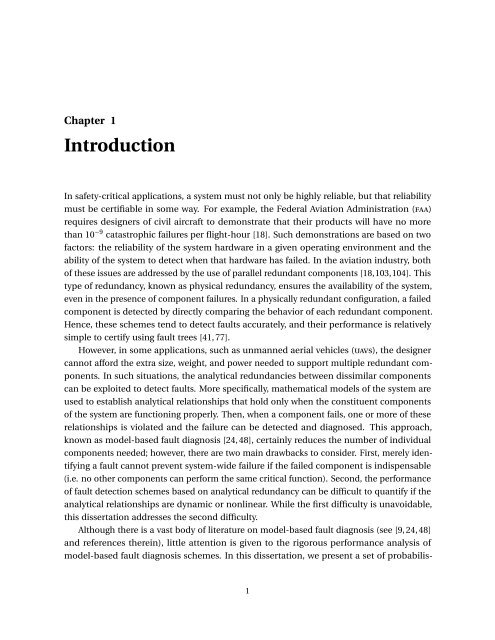Probabilistic Performance Analysis of Fault Diagnosis Schemes
Probabilistic Performance Analysis of Fault Diagnosis Schemes
Probabilistic Performance Analysis of Fault Diagnosis Schemes
You also want an ePaper? Increase the reach of your titles
YUMPU automatically turns print PDFs into web optimized ePapers that Google loves.
Chapter 1<br />
Introduction<br />
In safety-critical applications, a system must not only be highly reliable, but that reliability<br />
must be certifiable in some way. For example, the Federal Aviation Administration (faa)<br />
requires designers <strong>of</strong> civil aircraft to demonstrate that their products will have no more<br />
than 10 −9 catastrophic failures per flight-hour [18]. Such demonstrations are based on two<br />
factors: the reliability <strong>of</strong> the system hardware in a given operating environment and the<br />
ability <strong>of</strong> the system to detect when that hardware has failed. In the aviation industry, both<br />
<strong>of</strong> these issues are addressed by the use <strong>of</strong> parallel redundant components [18,103,104]. This<br />
type <strong>of</strong> redundancy, known as physical redundancy, ensures the availability <strong>of</strong> the system,<br />
even in the presence <strong>of</strong> component failures. In a physically redundant configuration, a failed<br />
component is detected by directly comparing the behavior <strong>of</strong> each redundant component.<br />
Hence, these schemes tend to detect faults accurately, and their performance is relatively<br />
simple to certify using fault trees [41, 77].<br />
However, in some applications, such as unmanned aerial vehicles (uavs), the designer<br />
cannot afford the extra size, weight, and power needed to support multiple redundant components.<br />
In such situations, the analytical redundancies between dissimilar components<br />
can be exploited to detect faults. More specifically, mathematical models <strong>of</strong> the system are<br />
used to establish analytical relationships that hold only when the constituent components<br />
<strong>of</strong> the system are functioning properly. Then, when a component fails, one or more <strong>of</strong> these<br />
relationships is violated and the failure can be detected and diagnosed. This approach,<br />
known as model-based fault diagnosis [24, 48], certainly reduces the number <strong>of</strong> individual<br />
components needed; however, there are two main drawbacks to consider. First, merely identifying<br />
a fault cannot prevent system-wide failure if the failed component is indispensable<br />
(i.e. no other components can perform the same critical function). Second, the performance<br />
<strong>of</strong> fault detection schemes based on analytical redundancy can be difficult to quantify if the<br />
analytical relationships are dynamic or nonlinear. While the first difficulty is unavoidable,<br />
this dissertation addresses the second difficulty.<br />
Although there is a vast body <strong>of</strong> literature on model-based fault diagnosis (see [9, 24, 48]<br />
and references therein), little attention is given to the rigorous performance analysis <strong>of</strong><br />
model-based fault diagnosis schemes. In this dissertation, we present a set <strong>of</strong> probabilis-<br />
1













